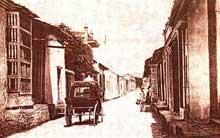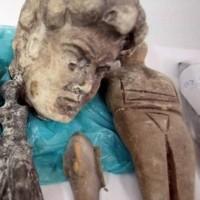INSTITUT SUPERIEUR D'ANTHROPOLOGIE
INSTITUTE OF ANTHROPOLOGY
ONLINE COURSES / COURS A DISTANCE
INSCRIPTION 2012 / Session II : Avril 2012
REGISTRATION 2012 / Term II : April 2012
FRANCE –  Moissac - Le patus, cet espace qui s'étend autour de l'abbaye vers le musée Marguerite-Vidal, va faire l'objet d'une grande campagne d'aménagement. Les équipes de l'Inrap, chargées d'effectuer les fouilles préventives avant les travaux, ont mis au jour des quantités de nouveaux éléments archéologiques. C'est à plus de trois mètres sous terre que les principales découvertes ont eu lieu. Cette profondeur correspond en fait au niveau du sol tel qu'il était au Moyen âge. En creusant, les archéologues sont tombés sur un os. Même plusieurs. Et c'est une bonne nouvelle. Les tranchées réalisées dans le jardin du musée ont permis de mettre la main sur un des mystères les plus intrigants de l'histoire moissagaise, à savoir la découverte de la chapelle de tous les saints, élément légendaire de l'abbatiale dont ne subsistaient que des traces écrites. De l'autre côté, c'est un ossuaire médiéval en briques rouges qui est mis en évidence. Les morts se faisaient traditionnellement enterrer au sein de l'église. Ces découvertes ont été consignées et un dossier a été transmis aux services de la DRAC. Elles n'entraîneraient pas de retard du chantier car leur profondeur devrait les préserver d'éventuelles dégradations.
Moissac - Le patus, cet espace qui s'étend autour de l'abbaye vers le musée Marguerite-Vidal, va faire l'objet d'une grande campagne d'aménagement. Les équipes de l'Inrap, chargées d'effectuer les fouilles préventives avant les travaux, ont mis au jour des quantités de nouveaux éléments archéologiques. C'est à plus de trois mètres sous terre que les principales découvertes ont eu lieu. Cette profondeur correspond en fait au niveau du sol tel qu'il était au Moyen âge. En creusant, les archéologues sont tombés sur un os. Même plusieurs. Et c'est une bonne nouvelle. Les tranchées réalisées dans le jardin du musée ont permis de mettre la main sur un des mystères les plus intrigants de l'histoire moissagaise, à savoir la découverte de la chapelle de tous les saints, élément légendaire de l'abbatiale dont ne subsistaient que des traces écrites. De l'autre côté, c'est un ossuaire médiéval en briques rouges qui est mis en évidence. Les morts se faisaient traditionnellement enterrer au sein de l'église. Ces découvertes ont été consignées et un dossier a été transmis aux services de la DRAC. Elles n'entraîneraient pas de retard du chantier car leur profondeur devrait les préserver d'éventuelles dégradations.
http://www.ladepeche.fr/article/2012/03/07/1300115-moissac-fouilles-au-patus-les-archeologues-tombent-sur-un-os.html
BULGARIE – Bisser - Several archaeological finds have been unearthed as work continues on clearing the debris following the flooding of the village of Bisser in southern Bulgaria. It was unclear whether the finds had been unearthed by the water flow or carried by the water, archaeologists from the Harmanli historical museum said. The stone slab appeared to be part of a Roman-era public building, while the hexagonal column was specific for the early Ottoman era. A similar column had been found near the village in the 1960s, BNT said.
Archaeologists from Harmanli would monitor the digging of foundations for new houses in Bisser to see if any other artifacts can be found, but that would not, in any way, delay the construction of new homes for the families that lost theirs in the flood.
http://www.sofiaecho.com/2012/03/07/1782459_archaeology-roman-slabstone-early-ottoman-column-discovered-after-bisser-disaster
CUBA –  Camagüey - A fragment of a 19th-century ceramic basin was the first find of the International Archaeological Team in charge of the excavation Works underway in the alleged foundation site of the former Santa Maria del Puerto del Principe Village, today Camagüey. This piece of evidence with a glaze in green seems to be a kind of bowl, and it was discovered by a group of researchers from Colombia, Argentina and Cuba in a place next to Nuevitas Bay (about 84 km north-east of Camagüey), where the first settlement is thought to have been built, in 1514 or 1515. The object was found in shallow depths, in a surface drill of 10 to 20 meters, as explained by M.Sc. Iosvany Hernández, head of the Archaeolog Cabinet of the Office of the City Historian of Camagüey (OHCC), which is sponsoring the project. Research coordinator Iosvany Hernández restated the belief that the site, off a coastal hill, was not completely scrapped with the transfer of the village, but remained populated up to a certain point sometime in the 19th century, with ups and downs bearing on the population index. As shown in earlier research, there are European and Indo-Cuban testimonies asserting this town was commonly known as Pueblo Viejo, yet no material evidence proving the existence of founding buildings has been spotted. The preparatory stage of the excavation works underway included remote sensing, which revealed there were human stools underground. Santa Maria del Puerto del Principe was later transferred to Caonao river banks, and from there, in 1528, it was removed to its final and definite location: a vast Mediterranean plain irrigated by rivers and creeks.
Camagüey - A fragment of a 19th-century ceramic basin was the first find of the International Archaeological Team in charge of the excavation Works underway in the alleged foundation site of the former Santa Maria del Puerto del Principe Village, today Camagüey. This piece of evidence with a glaze in green seems to be a kind of bowl, and it was discovered by a group of researchers from Colombia, Argentina and Cuba in a place next to Nuevitas Bay (about 84 km north-east of Camagüey), where the first settlement is thought to have been built, in 1514 or 1515. The object was found in shallow depths, in a surface drill of 10 to 20 meters, as explained by M.Sc. Iosvany Hernández, head of the Archaeolog Cabinet of the Office of the City Historian of Camagüey (OHCC), which is sponsoring the project. Research coordinator Iosvany Hernández restated the belief that the site, off a coastal hill, was not completely scrapped with the transfer of the village, but remained populated up to a certain point sometime in the 19th century, with ups and downs bearing on the population index. As shown in earlier research, there are European and Indo-Cuban testimonies asserting this town was commonly known as Pueblo Viejo, yet no material evidence proving the existence of founding buildings has been spotted. The preparatory stage of the excavation works underway included remote sensing, which revealed there were human stools underground. Santa Maria del Puerto del Principe was later transferred to Caonao river banks, and from there, in 1528, it was removed to its final and definite location: a vast Mediterranean plain irrigated by rivers and creeks.
http://www.cadenagramonte.cu/english/index.php?option=com_content&view=article&id=9836:camagueey-international-archaeological-team-makes-first-find-in-excavation-works&catid=1:camaguey&Itemid=14
GRECE –  – Chalkidiki - Some 9,500 ancient coins, mostly made of bronze, were confiscated by the police authorities of Chalkidiki after the last case of antiquities smuggling ring was exposed a few days ago. The majority of the coins comes from the broader Northern Greece region and dates back from the Byzantine era to the 5th century BC. Among the coins, several silver coins have also been found, mostly tetradrachms from the 4th century BC, cut by the Chalkidian Alliance and Phillipos II. Other small objects confiscated include bronze votive idols and jewelry, such as necklaces, rings, clasps and pins, most probably looted through illegal excavations on graves. Three golden mouthpieces of the 6th century BC stand out amidst the overall findings of the police research. Some of the findings were counterfeits, as announced by the experts, including a copy of a marble Cycladic idol and a small sculpture representing the Venus de Milo.
– Chalkidiki - Some 9,500 ancient coins, mostly made of bronze, were confiscated by the police authorities of Chalkidiki after the last case of antiquities smuggling ring was exposed a few days ago. The majority of the coins comes from the broader Northern Greece region and dates back from the Byzantine era to the 5th century BC. Among the coins, several silver coins have also been found, mostly tetradrachms from the 4th century BC, cut by the Chalkidian Alliance and Phillipos II. Other small objects confiscated include bronze votive idols and jewelry, such as necklaces, rings, clasps and pins, most probably looted through illegal excavations on graves. Three golden mouthpieces of the 6th century BC stand out amidst the overall findings of the police research. Some of the findings were counterfeits, as announced by the experts, including a copy of a marble Cycladic idol and a small sculpture representing the Venus de Milo.
http://greece.greekreporter.com/2012/03/06/counting-of-looted-antiquities-complete/
USA - Carrizo Plain - A renowned archaeological area in San Luis Obispo County is in the new class of National Historic Landmarks. Secretary of the Interior Ken Salazar announced Tuesday that the Carrizo Plain Archeaological District is one of 13 new Historic Landmarks in nine states. The announcement says the Carrizo Plain is a unique concentration of pre-European art and artifacts whose significance has been recognized for nearly a century by researchers, artists and writers. Within the district's dozens of sites are pictographs and panels made by early North American hunter-gatherers that make it one of the biggest and best collections of painted rock in the United States. Other new landmarks announced Tuesday are the Montauk Point Lighthouse in Long Island, New York and a group of Frank Lloyd Wright-designed buildings in Florida.
http://www.therepublic.com/view/story/31efa461f3c34976b5ef7e00cc93006a/CA--New-Historic-Landmarks-California/